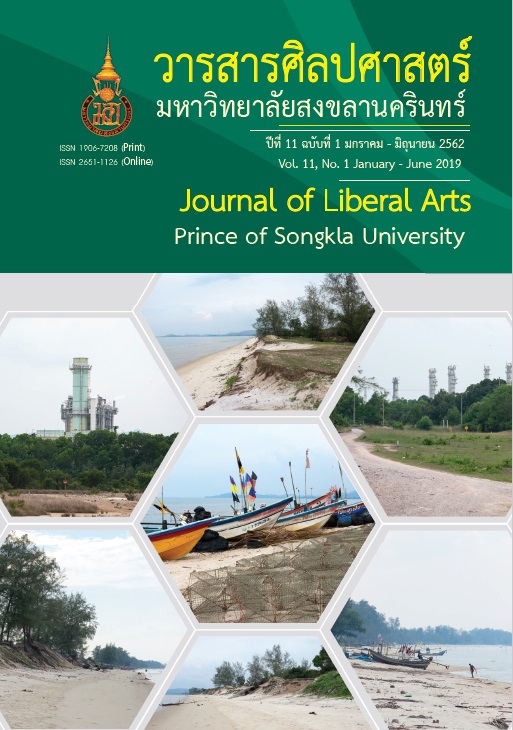Factors affecting teachers’ use of technologies as teaching aids in Thai EFL classrooms
Keywords:
Factors affecting the use of technology, teaching aids, teachers’ use of technologyAbstract
In the digital age, technology plays a dominant role in creating and exchanging knowledge and information in the field of education around the globe. In Thailand, it has also been used as a teaching aid in English language teaching and learning for decades. However, a gap of using technology in Thai EFL classrooms taught by English language teachers has been found. This study therefore aims to investigate types of technology tools used by language teachers as well as factors that facilitate and hinder their use of technologies in Thai EFL classrooms. The data was obtained by implementing semi-structured interviews. Twelve EFL teachers with varied numbers of years of teaching experience in a public high school in Bangkok were interviewed. The interview data was transcribed and classified into themes. The findings revealed that all teachers integrated technologies in their classes. Certain types of tools are already used by all teachers, while some cutting-edge tools are presently being integrated in the classrooms. Convenience, enhancement to students’ understanding, and stimulation in students’ interest are three prominent factors facilitating teachers’ use of technology. However, several factors hindering their use of technology were also found. On the basis of these findings, the pedagogical implications and suggestions are included in this paper.
References
Abukhattala, I. (2016). The use of technology in language classrooms in Libya. International Journal of Social Science and Humanity, 6(4), 262-267.
Agnes, C., & Wallace, C. (2010). An investigation of factors affecting the use of ICT for teaching in the Western Cape schools. 18th European Conference on Information Systems, Pretoria, South Africa, 7-9 June, pp. 61-72.
Ahadiat, N. (2005). Factors that may influence or hinder use of instructional technology among accounting faculty. Campus-Wide Information Systems, 22(4), 210-232.
Almekhlafi, A. G., & Almeqdadi, F. A. (2010). Teachers’ perceptions of technology Integration in the United Arab Emirates school classrooms. Educational Technology & Society, 13(1), 165–175.
Alsied, S. M., & Pathan, M. M. (2013). The use of computer technology in EFL classroom: Advantages and implications. International Journal of English Language & Translation Studies, 1(1), 61-71.
Amina, M., & Salim, M. (2015). The use of educational technology in EFL teaching and learning : Case study of second year sstudents at Tlemcen University. Master in Language Studies, English Language Studies, Faculty of Letters and Languages, Tlemcen Univresity.
Asawaniwed, P., & Boonmoh, A. (2012). Attitudes of Thai EFL learners toward the use of blogs. The Fourth TCU International E-Learning Conference, Muang Thong Thani, Nonthaburi, Thailand, 14-15 June, pp. 313-319.
Bani Hani, N. A. (2014). Benefits and barriers of computer assisted language learning and teaching in the Arab world: Jordan as a model. Theory and Practice in Language Studies, 4 (8), 1609-1615.
ChanLin, L.-J., Hong, J.-C., Horng, J.-S., Chang, S.-H., & Chu, H.-C. (2006). Factors influencing technology integration in teaching: a Taiwanese perspective. Innovations in Education and Teaching International, 43(1), 57-68.
Durđanović, M. M. (2015). The use of teaching aids and their importance for students’ music education. (IJCRSEE) International Journal of Cognitive Research in Science, Engineering and Education, 3(2), 33-40.
Eady, M. J., & Lockyer, L. (2013). Tools for learning: Technology and teaching strategies. University of Wollongong Research Online, 14(1), 71-89.
Günüç, S., & Kuzu, A. (2014). Factors influencing student engagement and the role of technology in student engagement in higher education: Campus-class-technology theory. Turkish Online Journal of Qualitative Inquiry, 5(4), 86-113.
Herschbach , D. R. (1995). Technology as knowledge: Implications for instruction. Journal of Technology Education, 7(1), 31-42.
Hjalmarsson, H. (2015). The effects of ICT on affective factors and teaching practices in the EFL and ESL classroom. Master’s thesis in Teacher Education, Languages and Literatures, Faculty of Education, Gothenburg University.
Konomi, D. K. (2015). Using visual materials in teaching vocabulary in English as a foreign language classrooms with young learners. International Conference New Perspectives in Science Education, Firenze, Italy, 20-21 March, pp. 23-35.
Lin, M.-H., Chen, H.-C., & Liu, K.-S. (2017). A study of the effects of digital learning on learning motivation and learning outcome. EURASIA Journal of Mathematics Science and Technology Education, 13(7), 3553-3564.
Merç, A. (2015). Using technology in the classroom: A study with Turkish pre-service EFL teachers. TOJET: The Turkish Online Journal of Educational Technology, 14(2), 229-240.
Prensky, M. (2001). Digital natives, digital immigrants. MCB University Press, 9(5), 2-6
Senaidi, S., Lin, L., & Poirot, J. (2009). Barriers to adopting technology for teaching and learning in Oman. Computers & Education, 53(3), 575-590.
Shabiralyani, G., Hasan, K. S., Hamad, N., & Iqbal, N. (2015). Impact of visual aids in enhancing the learning process case research: District Dera Ghazi Khan. Journal of Education and Practice, 6 (19), 226-233.
Shivalingaiah , D., & Naik, U. (2009). Comparative study of Web 1.0, Web 2.0 and Web 3.0. Conference: 6th International CALIBER 2008, Allahabad, Uttar Pradesh, India, 28-28 February, pp. 499-507.
Shyamlee, S. D., & Phil, M. (2012). Use of technology in English language teaching and learning: An analysis. 2012 International Conference on Language, Medias and Culture ICLMC, Chennai, India, 10-11 March, pp. 151-156.
Solomon, G., & Schrum, L. (2007). Web 2.0: New tools, new schools . International Society for Technology in Education, the United States of America.
Yordming, R. (2017). Teachers’ perspective towards digital teaching tools in Thai EFL classrooms. International Journal of Languages, Literature and Linguistics, 3(2), 45-48.
Downloads
Published
How to Cite
Issue
Section
License
The authors retain the copyright to their article but the Journal of Liberal Arts, Prince of Songkla University reserves the exclusive rights to first publication.






